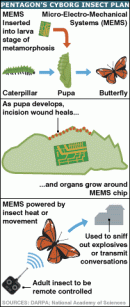



The idea is to insert micro-systems at the pupa stage, when the insects can integrate them into their body, so they can be remotely controlled later.
Experts told the BBC some ideas were feasible but others seemed "ludicrous".
A similar scheme aimed at manipulating wasps failed when they flew off to feed and mate.
The new scheme is a brainwave of the Defence Advanced Research Projects Agency (Darpa), which is tasked with maintaining the technological superiority of the US military.
It has asked for "innovative" bids on the insect project from interested parties.
'Assembly-line'
Darpa believes scientists can take advantage of the evolution of insects, such as dragonflies and moths, in the pupa stage.
"Through each metamorphic stage, the insect body goes through a renewal process that can heal wounds and reposition internal organs around foreign objects," its proposal document reads.
The foreign objects it suggests to be implanted are specific micro-systems - Mems - which, when the insect is fully developed, could allow it to be remotely controlled or sense certain chemicals, including those in explosives.
The invasive surgery could "enable assembly-line like fabrication of hybrid insect-Mems interfaces", Darpa says.
A winning bidder would have to deliver "an insect within five metres of a specific target located 100 metres away".
The "insect-cyborg" must also "be able to transmit data from relevant sensors, yielding information about the local environment. These sensors can include gas sensors, microphones, video, etc."
'Fiction'
Scientists who spoke to the BBC news website were unconvinced.
Entomology expert Dr George McGavin of the Oxford University Museum of Natural History said the idea appeared "ludicrous".
"Not all wacky ideas are without value. Some do produce the goods. My feeling is this will probably not produce the goods," he said.
"What adult insects want to do is basically reproduce and lay eggs. You would have to rewire the entire brain patterns."
Dr McGavin said it appeared impossible to connect the technology to the right places during the metamorphic phase, particularly with regard to flight.
Prof Andrew Parker, research leader at the Natural History Museum's zoology department and a specialist in bio-mimetics, said the concept was not too far fetched but had its limits.
Technology could help direct an insect to chemicals such as in roadside bombs, he said, but controlling full flight was "a long way off".
Entomology expert at the museum, Stuart Hine, agreed it was plausible to use insects to detect explosives.
But he added: "I feel that the reality of such cyborg fusion between insect and machine lies squarely in the realms of fiction."
To receive micro-signals from the insects would require a dish "quite close and several feet in diameter, rendering it a less than covert operation".
Darpa's previous experiments to get bees and wasps to detect the smell of explosives foundered when their "instinctive behaviours for feeding and mating... prevented them from performing reliably", it said.
Darpa was founded in 1958 to keep US military technology ahead of Cold War rivals.
Its website says it has around 240 personnel and a $2bn (£1.1bn) budget. Supporters say much of its work has been successful, but it has also drawn criticism for unusable "blue-sky" projects.
A former director said in 1975: "When we fail, we fail big."
March 19, 2006
MORE (Cyborg Beetle)
BBC News
